As the backbone of the economy, financial stocks present both opportunities and risks for investors. From major banks and insurance giants to innovative fintech companies, this sector reflects economic trends and market movements. However, financial stocks are influenced by economic conditions, regulatory changes, and broader market sentiment, which can lead to volatility.
In this article, we’ll dissect the various types of financial stocks, spotlight industry leaders, and delve into the key factors that drive their performance. Whether you’re aiming to diversify your portfolio or seeking tactical trading strategies, understanding the intricacies of financial stocks is essential for navigating today’s dynamic market.
Key Takeaways
- Learn more about the stock performance of top financial stocks like JPMorgan, Goldman Sachs, and Berkshire Hathaway.
- Financial stocks are influenced by interest rates, economic indicators like GDP and unemployment, regulatory changes, and market sentiment, reflecting broader economic trends.
- When trading financial stocks, implement technical and fundamental analysis to optimise your trading strategy while managing risk effectively.
What are Financial Stocks
Financial stocks refer to shares of companies that are part of the financial sector. This includes banks, investment firms, insurance companies, and real estate firms. These companies are crucial to the economy as they facilitate transactions, provide loans, manage investments, and offer insurance services.
Why Trade Financial Stocks
Before diving into specific financial stocks, here are several reasons to consider adding them to your trading strategy:
1. Liquidity: Financial stocks tend to be highly liquid, meaning shares can be bought and sold with ease. However, liquidity can fluctuate depending on market conditions.
2. Dividends: Many financial stocks, especially banks and insurance companies, may pay dividends, providing investors with a potential income stream. However, dividend payments are not guaranteed and can be impacted by economic conditions and company performance. This can be particularly attractive during periods of low capital gains.
3. Economic Influence: The performance of financial stocks often reflects broader economic conditions. As such, trading these stocks can provide insights into economic trends and investor sentiment.
4. Diversification: Including financial stocks in a portfolio may offer diversification benefits. In recent months, Morgan Stanley’s Global Investment Committee has repeatedly urged investors to seek maximum portfolio diversification in 2025 [1].
Examples of Top Financial Stocks
In this section, we will be showcasing some of the top performing financial stocks. Some of these names might sound familiar to you.
1. JPMorgan Chase & Co. (NYSE:JPM) [2,3,4,5]
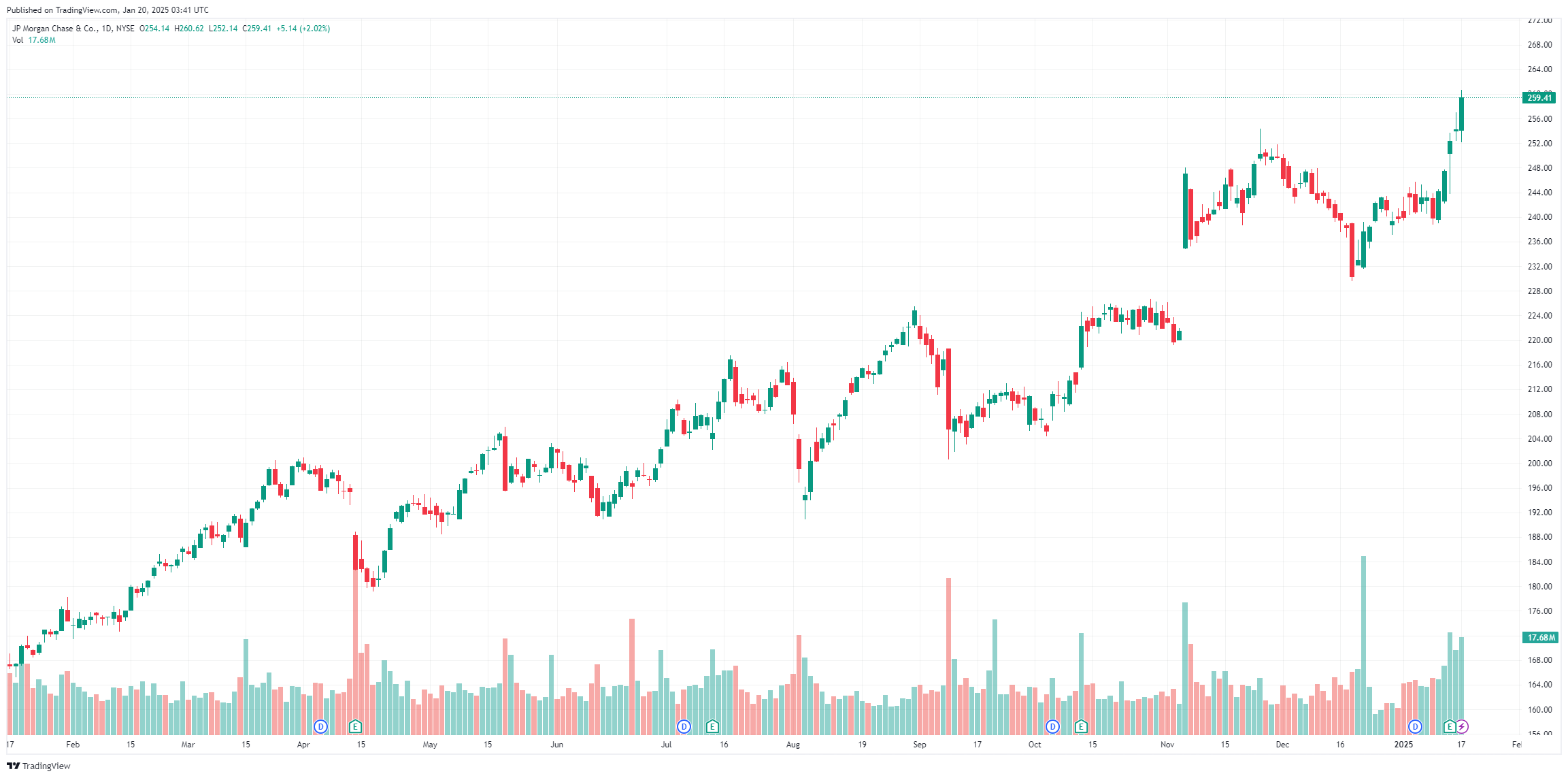
JPMorgan’s stock saw significant volatility over the past year, beginning with a strong rise in November 2023, following a 35% increase in Q3 profits driven by higher interest income and resilient consumer health. This momentum slowed in April 2024, when the stock dropped after reporting lower-than-expected net interest income of $23.2 billion for the first quarter, which came in below analysts’ forecasts.
However, the stock rebounded in October 2024, rising after the bank posted strong third-quarter results with revenue of $42.65 billion, surpassing the consensus estimate of $40.85 by 4.4%. While profits dipped slightly year-over-year, earnings per share were $4.37, exceeding analysts’ expectations of $3.97 per share.
JPMorgan Chase had a strong fourth quarter, with profits jumping 50% to $14 billion and revenue rising 11% to $42.77 billion. The bank reported record figures in its payments and asset-management divisions, driven by increased optimism and activity among corporate clients.
As of 31 January 2025, JPM is trading at $266.81.
2. Goldman Sachs Group Inc. (NYSE:GS) [6,7,8,9]
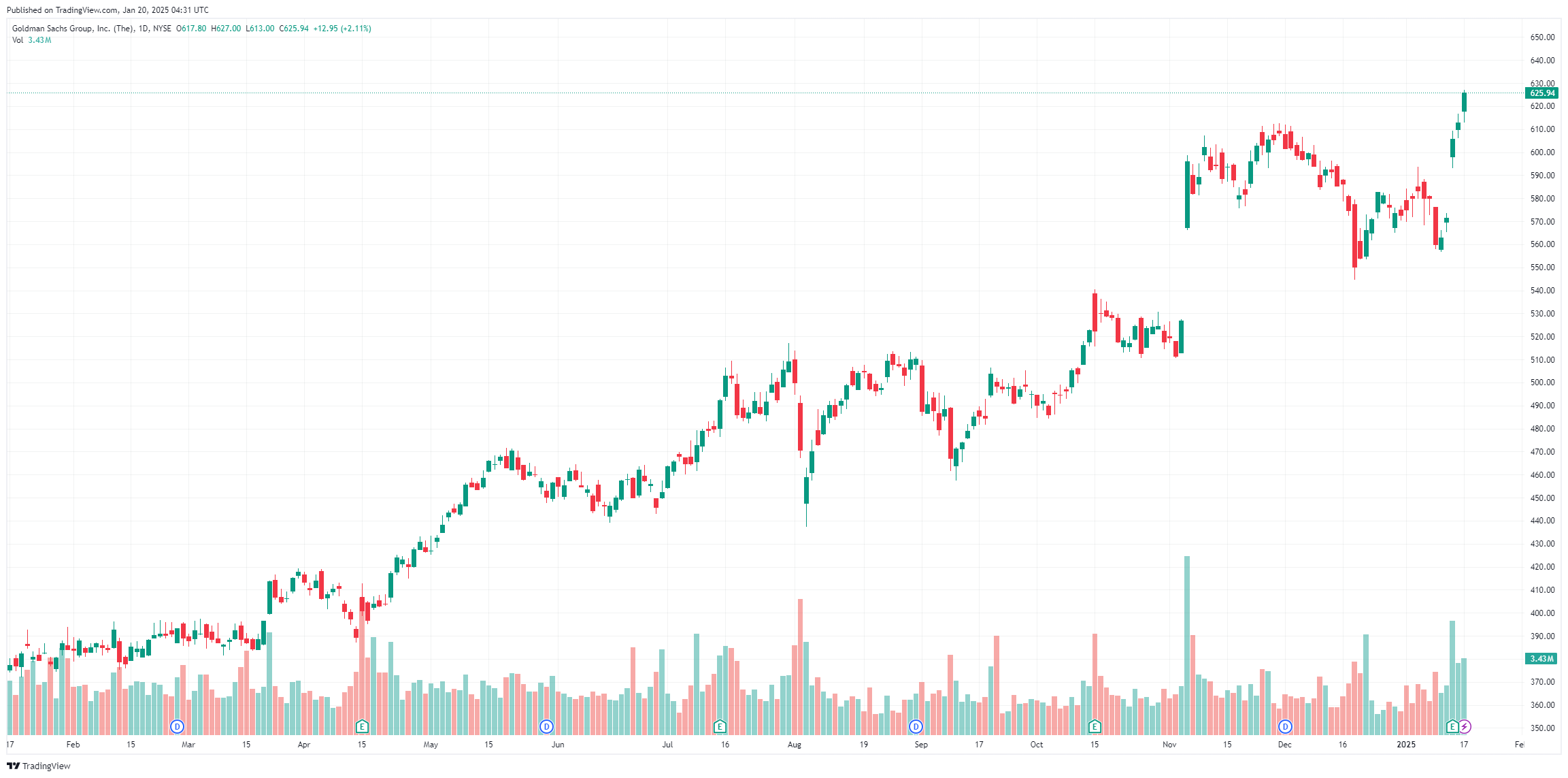
Goldman Sachs’ stock experienced notable fluctuations throughout the past year. The stock began its upward trajectory in early 2024, driven by strong first-quarter results. In April 2024, Goldman Sachs reported net revenues of $14.21 billion and net earnings of $4.13 billion for Q1, reflecting a 16% increase in net revenues compared to the same period in 2023.
The momentum continued into the third quarter, with Goldman Sachs posting net revenues of $12.70 billion and net earnings of $2.99 billion for Q3 2024
Goldman Sachs reported a strong fourth quarter, with profits roughly doubling due to surging revenues from deal-making, underwriting, and trading. CEO David Solomon expressed optimism about business prospects under the incoming administration, noting increased CEO confidence and a significant backlog in deal-making. The bank’s shares have risen nearly 60% over the past 12 months, reflecting investor confidence.
As of 31 January 2025, GS is trading at $632.37.
3. Berkshire Hathaway Inc. (NYSE:BRK.B) [10,11,12]
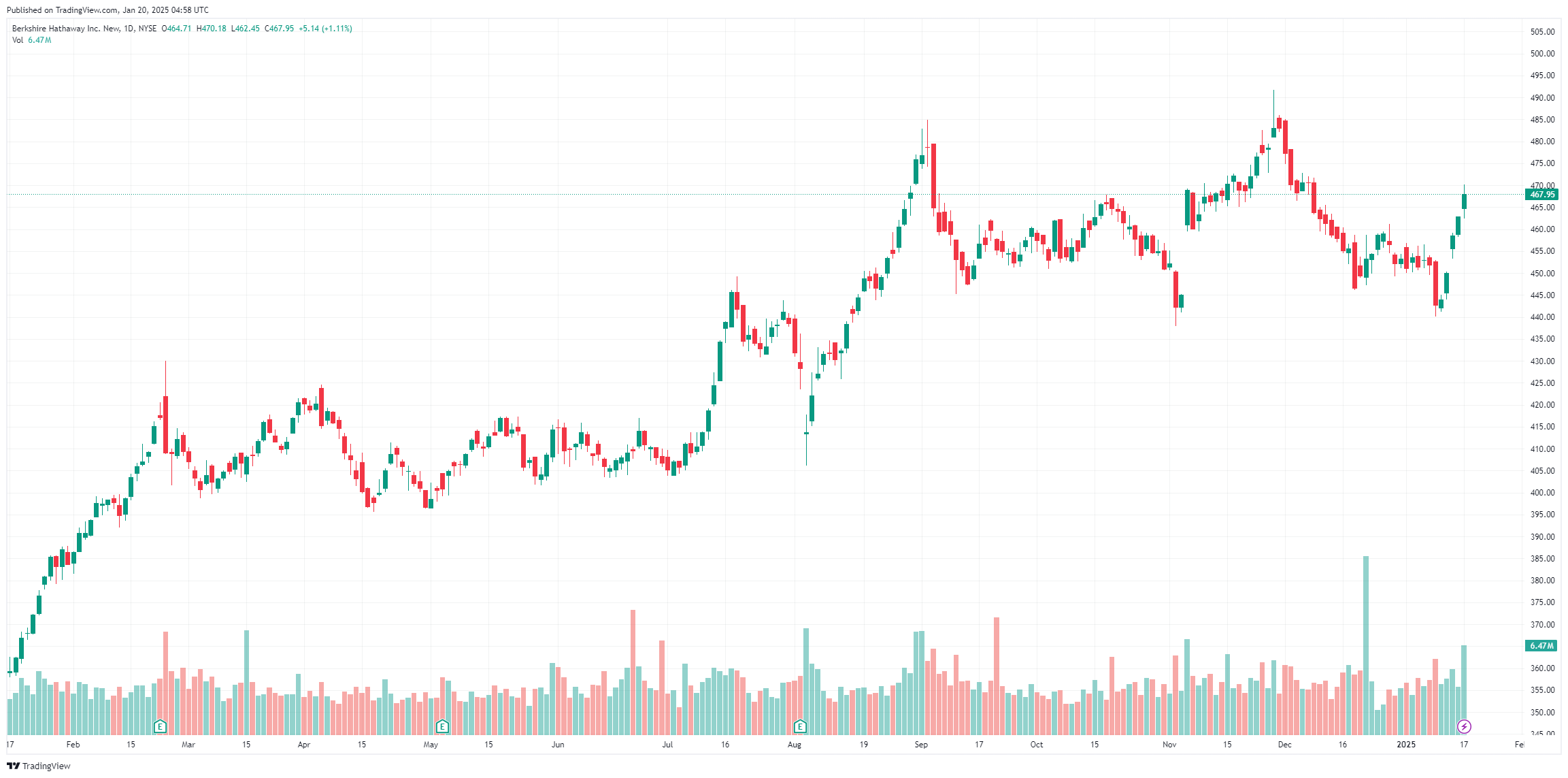
Berkshire Hathaway stocks are split into two options: Class A and Class B. In this article, we will focus on Class B.
In Q4 2024, Berkshire Hathaway reported a 28% year-over-year increase in operating earnings, reaching $8.5 billion. This growth was driven by higher earnings in insurance underwriting and investment income. The company’s total revenue for the quarter rose by 20.7% to $364.5 billion, with significant contributions from its insurance, railroad, utilities, and energy segments.
Additionally, Berkshire Hathaway is holding a significant amount of cash this year, with $325.21 billion in cash and cash equivalents. Warren Buffett’s decision to hold such a large cash reserve can influence market sentiment, as it may signal caution or readiness for future investments.
Furthermore, Berkshire Hathaway has trimmed a large portion of its Apple share holdings this year, which could impact the stock’s performance and market perception.
As of 31 January 2025, BRK.B is trading at $464.61.
4. American Express Company (NYSE:AXP) [13,14,15]
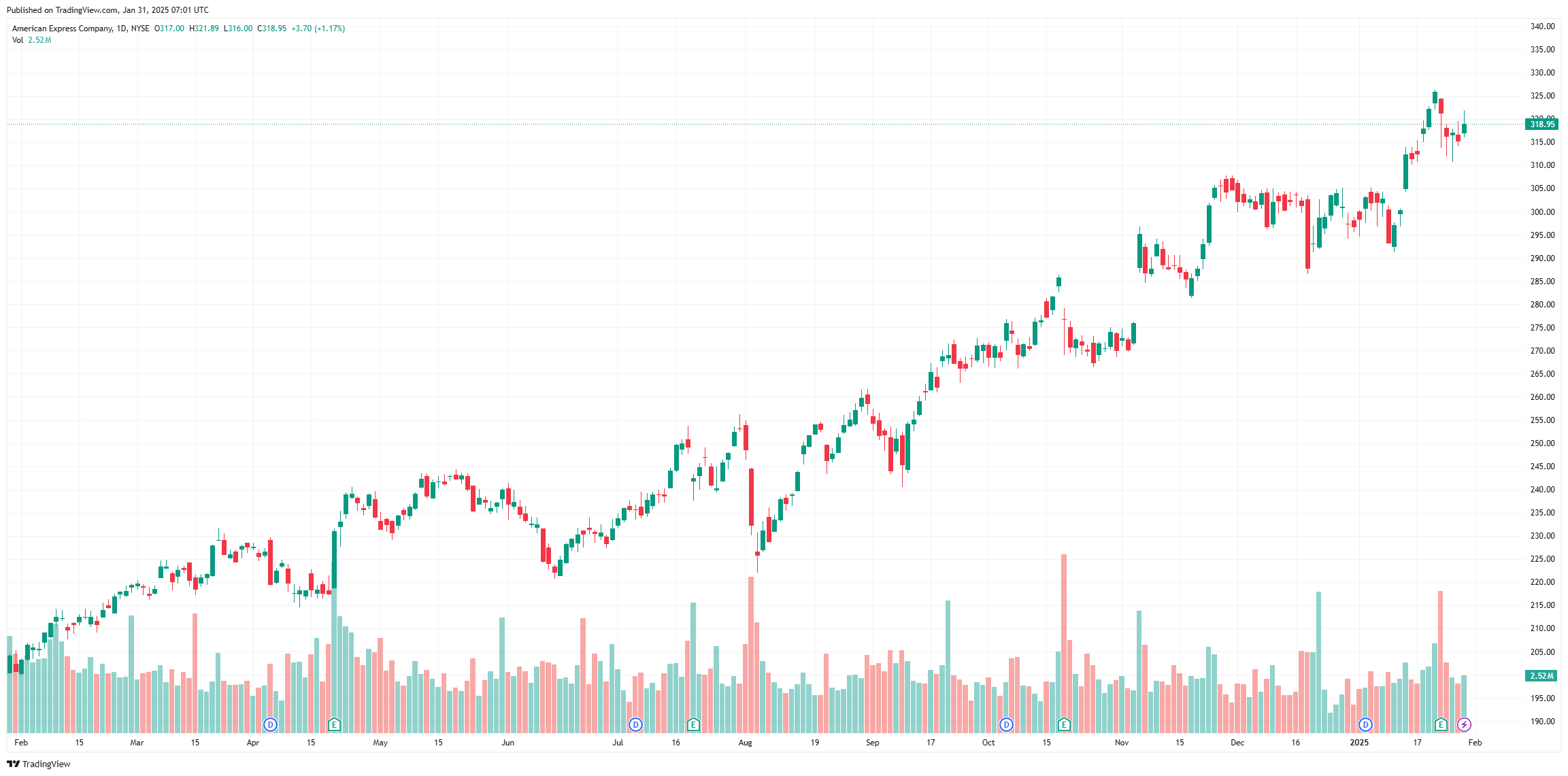
American Express Company (AXP) has shown strong performance over the past year. The stock rose significantly in early 2024, driven by Q1 net revenues of $15.8 billion and net earnings of $3.33 per share, an 11% increase from the previous year.
In the last quarter of 2024, American Express reported an 8.7% revenue increase to $17.2 billion, driven by a 7.5% rise in card member spending. Earnings per share grew 16% to $3.04, surpassing analysts’ expectations. CEO Stephen J. Squeri highlighted record annual revenues, net income, card member spending, and new card acquisitions.
Additionally, American Express announced a 17.1% dividend increase to 82 cents per share, marking the fourth consecutive year of dividend hikes.
As of 31 January 2025, AXP is trading at $316.53.
5. Visa Inc. (NYSE:V) [16,17,18]
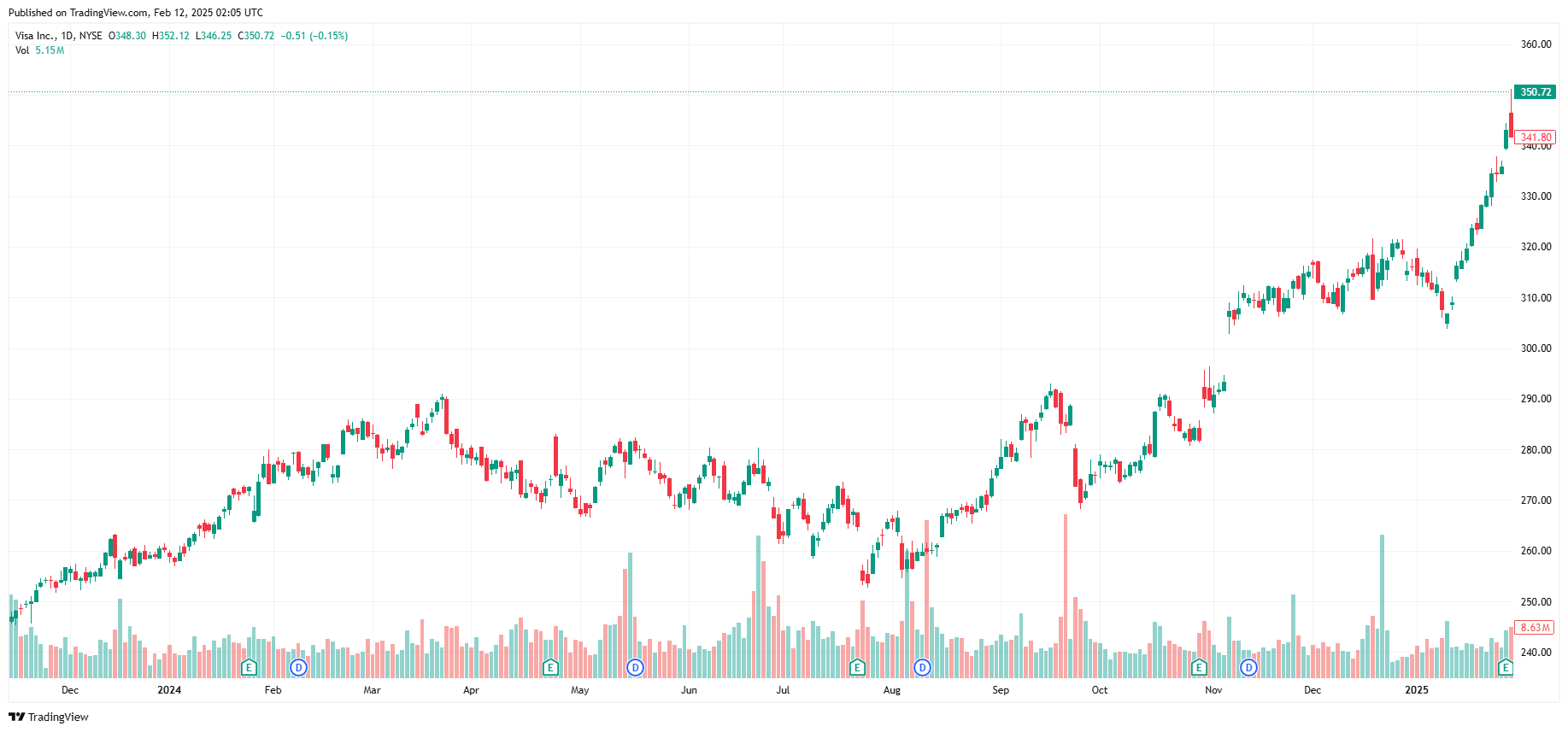
Visa Inc. (V) has experienced steady growth and some fluctuations in its stock performance throughout the past year. The stock began its upward trend in early 2024, driven by strong first-quarter results. In January 2024, Visa reported net revenues of $8.6 billion marking a 9% increase on both nominal and constant-dollar basis.
The company reports a net revenue of $35.9 billion for the full fiscal year. This performance was bolstered by increased consumer spending and the company’s expansion in digital payments.
Visa reported strong fiscal first-quarter results for 2025, with earnings per share (EPS) of $2.75, surpassing analysts’ expectations of $2.66. The company’s revenue rose to $9.51 billion, driven by robust payment volumes and a surge in cross-border transactions. The company has also partnered with X to enable users to move funds between traditional bank accounts and their digital wallets, facilitating instant peer-to-peer payments.
As of 31 January 2025, V is trading at $345.82.
Factors Influencing Financial Stocks
Interest Rates
Interest rates have a significant impact on the profitability of banks and financial institutions. When rates rise, banks may be able to charge more for loans, such as mortgages, business loans, and credit cards, potentially expanding their interest margins. Higher rates can also influence demand for fixed-income products, which may benefit investment firms.
As of January 2025, the Federal Reserve has kept the interest rate steady at 4.25%-4.5% [19]. The Federal Reserve has signalled a slower pace of rate cuts than previously anticipated, which could affect borrowing costs and investment returns.
Economic Indicators
The performance of financial stocks is influenced by key economic indicators, including GDP growth, unemployment rates, inflation, and consumer confidence. In periods of economic expansion, rising GDP can support increased lending, investment, and spending, which may have a positive impact on banks, asset management firms, and insurers.
For example, low unemployment and high consumer spending can contribute to greater demand for loans, credit, and investment services, which may affect profitability. As of the third quarter of 2024, the US GDP increased at an annual rate of 3.1% [20].
Regulatory Changes
Financial institutions operate in a highly regulated sector, and changes in regulation can significantly influence their profitability, risk profile, and growth potential. Stricter capital requirements, such as those introduced by Basel III, may affect a bank’s ability to lend and invest in higher-risk assets, which could impact its earnings potential.
Market Sentiment
Market sentiment plays an important role in influencing the stock prices of financial companies. Positive investor sentiment, often supported by favourable economic news, earnings reports, or sector-specific developments, may contribute to increased demand for financial stocks, which can affect prices. For example, optimism around economic growth may encourage investment in financial institutions, particularly banks and asset managers, as investors anticipate potential changes in profitability.
Tips to Trade Financial Stocks
Fundamental Analysis
When trading financial stocks, it’s essential to perform in-depth fundamental analysis. This involves evaluating key financial statements such as balance sheets, income statements, and cash flow statements.
Key ratios like the price-to-earnings (P/E) ratio, return on equity (ROE), and net interest margin (NIM) are particularly important in assessing the financial health and profitability of companies in this sector. The P/E ratio helps gauge whether a stock is overvalued or undervalued, while ROE measures how efficiently a company generates profit relative to shareholder equity. NIM, a key metric for banks, indicates how well they are managing their interest income compared to their interest expenses.
A solid understanding of these financials can help traders to make more informed decisions on stock selection.
Technical Analysis
In addition to fundamental analysis, technical analysis plays a crucial role in trading financial stocks. Traders use charts and various technical indicators to analyse trends and assess potential price movements.
Commonly used tools include moving averages, Relative Strength Index (RSI), and Bollinger Bands. Moving averages smooth out price data to help identify trends, while RSI is useful for identifying overbought or oversold conditions in a stock. Bollinger Bands offer insights into the volatility of a stock and help traders determine whether the price is likely to break out.
By recognising support and resistance levels—prices at which stocks have historically had difficulty moving beyond—traders can spot potential entry and exit points with greater accuracy.
Understanding Market Conditions
Market conditions significantly impact financial stock performance. It is crucial to stay informed about economic indicators, such as GDP growth, unemployment rates, and inflation, as well as any changes in monetary policy decisions made by central banks. Interest rates, in particular, can have a direct effect on the profitability of financial institutions.
For instance, when central banks raise interest rates, banks can increase the spread between the rates they charge on loans and the rates they pay on deposits, boosting their net interest margins. Traders may benefit from monitoring these macroeconomic factors and considering how they could influence stock prices in the financial sector when making strategic decisions.
Diversification Strategies
Diversification is key to managing risk. Rather than concentrating investments in a single financial sector—such as banks—consider diversifying within the broader financial space. This may include insurance companies, asset managers, and fintech companies.
Each segment has its own dynamics, and by spreading your investments across different types of financial stocks, you can take advantage of varying market trends and reduce the impact of sector-specific risks. For example, while a rising interest rate environment could possibly benefit banks, it may not have the same positive effect on insurance companies. A diversified portfolio allows traders to balance risk and capitalise on different economic conditions.
Risk Management
Effective risk management is essential for long-term success. One of the most important aspects is setting clear entry and exit points before initiating a trade. Using stop-loss orders is an effective strategy to limit losses if the stock moves against your position.
It’s also important to understand your own risk tolerance—how much you are willing to lose on any given trade—and to manage position sizes accordingly.
By implementing a disciplined risk management strategy, traders may reduce exposure to significant losses while positioning themselves for potential opportunities.
Conclusion
To wrap up, financial stocks play a significant role in the investment landscape, offering potential opportunities for growth, income, and diversification. Their connection to economic performance and market sentiment makes them an important sector to analyse for investor and trader.
From traditional stock purchases to leveraged products like CFDs and futures, there are multiple ways to gain exposure to financial stocks. Stay informed with Vantage’s Academy to learn more about the key market drivers, associated risk, and considerations for navigating this dynamic sector.
Ready to trade financial stocks via CFDs with a trusted broker? Sign up with Vantage today to access top US financial stock CFDs at $0 commission*.
*Other fees may apply
References
- “Outlook 2025: The Case for Portfolio Diversification – Morgan Stanley”. https://www.morganstanley.com/ideas/2025-market-outlook-portfolio-diversification . Accessed 4 February 2025.
- “JPMorgan Chase Q3 profit jumps 35% amid global uncertainties – Investing.com”. https://www.investing.com/news/stock-market-news/jpmorgan-chase-q3-profit-jumps-35-amid-global-uncertainties-93CH-3198278 . Accessed 11 December 2024.
- “Markets News, April 12, 2024: Stocks Tumble as Big Banks Kick Off Q1 Earnings, Interest Rate Jitters Linger – Investopedia”. https://www.investopedia.com/dow-jones-today-04122024-8630566 . Accessed 11 December 2024.
- “JPMorgan Stock Rises as Q3 Earnings Handily Beat Estimates – Investopedia”. https://www.msn.com/en-us/money/topstocks/jpmorgan-stock-rises-as-q3-earnings-handily-beat-estimates/ar-AA1s5IPD . Accessed 11 December 2024.
- “JPMorgan Chase and Goldman Sachs Post Surging Profits – The Wall Street Journal”. https://www.wsj.com/business/earnings/jpmorgan-chase-earnings-report-4q-2024-jpm-835747eb. Accessed 20 January 2025.
- “First Quarter 2024 Earnings Results – Goldman Sachs” . https://www.goldmansachs.com/pressroom/press-releases/current/pdfs/2024-q1-results.pdf . Accessed 11 December 2024.
- “Third Quarter 2024 Earnings Results – Goldman Sachs” . https://www.goldmansachs.com/pressroom/press-releases/current/pdfs/2024-q3-results.pdf . Accessed 11 December 2024.
- “The Goldman Sachs Group (GS) Stock Chart & Stock Price History – MarketBeat” https://www.marketbeat.com/stocks/NYSE/GS/chart/ . Accessed 11 December 2024.
- “Goldman Sachs soars on Q4 earnings, CEO sounds caution on Trump tariff and immigration plans – Fortune”. https://fortune.com/2025/01/15/goldman-sachs-david-solomon-trump/. Accessed 20 January 2025.
- “Berkshite Hathaway Inc. – Berkshire Hathaway” . https://www.berkshirehathaway.com/qtrly/1stqtr24.pdf . Accessed 11 December 2024.
- “Berkshire Hathaway (BRK.B) Q4 Earnings Rise Year Over Year – Yahoo!Finance”. https://finance.yahoo.com/news/berkshire-hathaway-brk-b-q4-151400380.html . Accessed 31 January 2025.
- “Berkshire Hathaway (BRK-B) – Cash on Hand – Companies Market Cap”. https://companiesmarketcap.com/berkshire-hathaway/cash-on-hand/ . Accessed 31 January 2025.
- “American Express (AXP) Stock Chart & Stock Price History – MarketBeat”. https://www.marketbeat.com/stocks/NYSE/AXP/chart/ . Accessed 11 December 2024.
- “American Express First-Quarter Revenue Increased 11% to $15.8 Billion and EPS Increased 39% to $3.33, Reflecting Continued Business Momentum – American Express”. https://ir.americanexpress.com/news/investor-relations-news/investor-relations-news-details/2024/American-Express-First-Quarter-Revenue-Increased-11-to-15.8-Billion-and-EPS-Increased-39-to-3.33-Reflecting-Continued-Business-Momentum/default.aspx . Accessed 11 December 2024.
- “What American Express’ Latest Dividend Hike Means for Investors – Kiplinger”. https://www.kiplinger.com/investing/stocks/what-american-express-axp-latest-dividend-hike-means-for-investors . Accessed 31 January 2025.
- “Visa Inc (V) Reports 9% Revenue Growth and Robust Earnings in Q1 2024 – Yahoo!Finance” . https://finance.yahoo.com/news/visa-inc-v-reports-9-213504594.html . Accessed 11 December 2024.
- “Visa Fiscal First Quarter 2025 Financial Results – Visa”. https://investor.visa.com/news/news-details/2025/Visa-Fiscal-First-Quarter-2025-Financial-Results/default.aspx . Accessed 31 Janaury 2025.
- “Elon Musk’s X begins its push into financial services with Visa deal – CNBC”. https://www.msn.com/en-us/money/companies/elon-musks-x-begins-its-push-into-financial-services-with-visa-deal/ar-AA1y0jQF . Accessed 31 January 2025.
- “United States Fed Funds Interest Rate – Trading Economics”. https://tradingeconomics.com/united-states/interest-rate . Accessed 31 January 2025.
- “Gross Domestic Product, 4th Quarter and Year 2024 (Advance Estimate) – Bureau of Economic Analysis”. https://www.bea.gov/data/gdp/gross-domestic-product . Accessed 31 January 2025.



